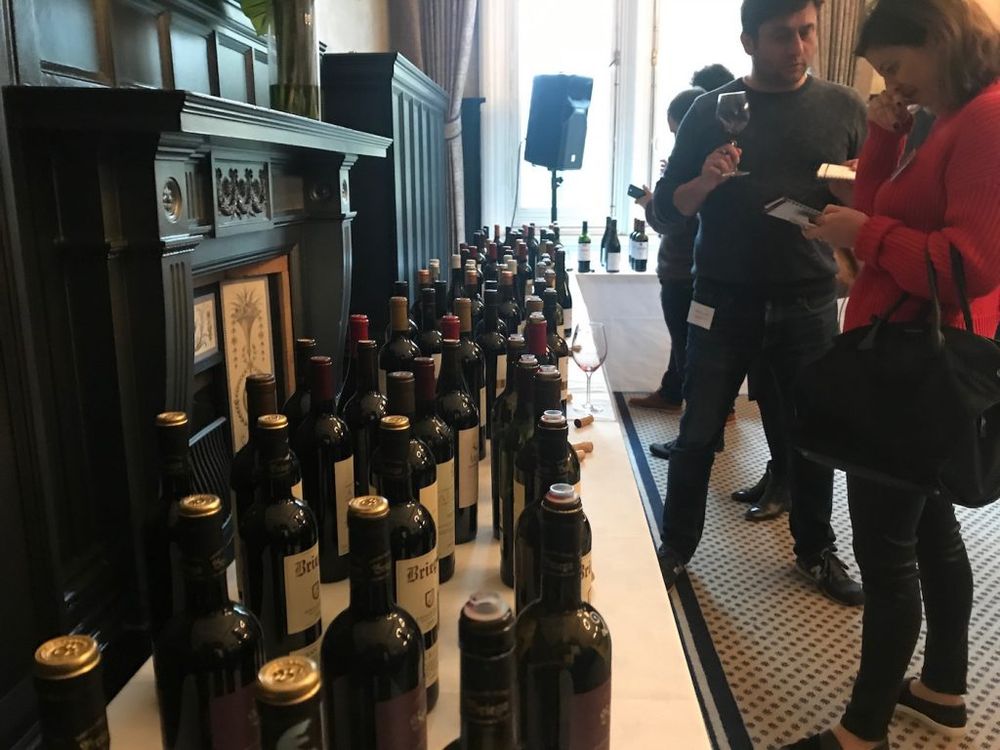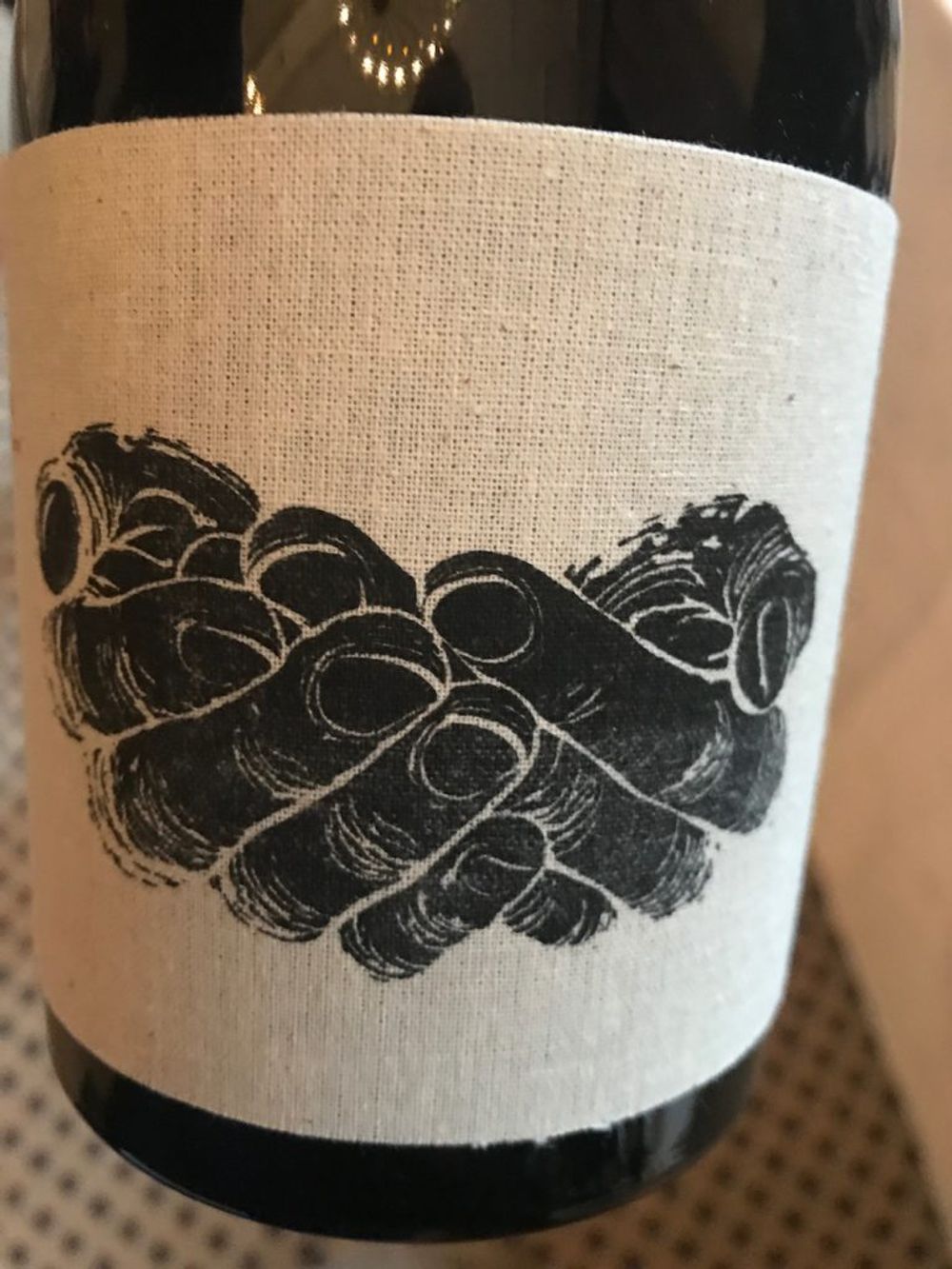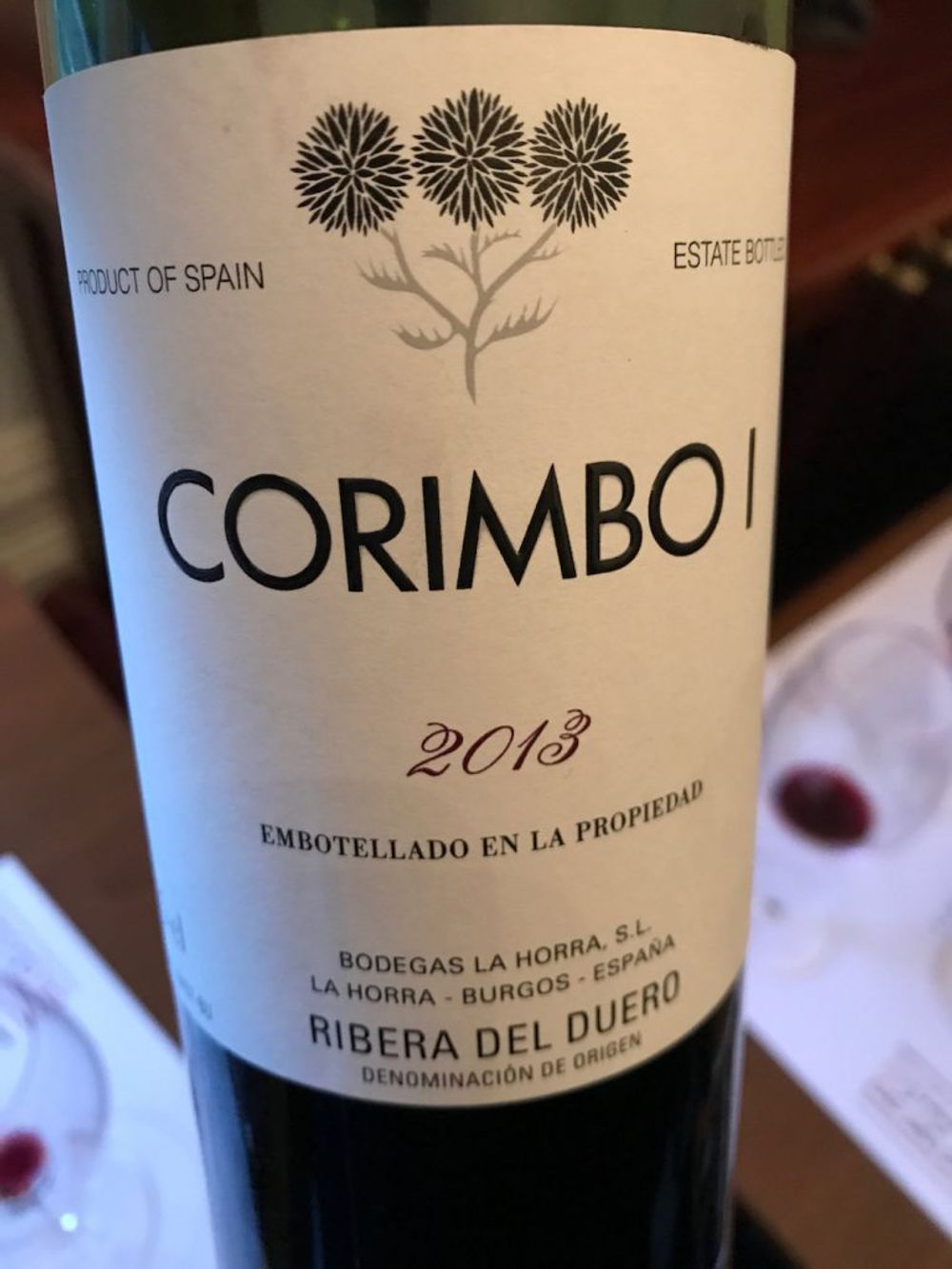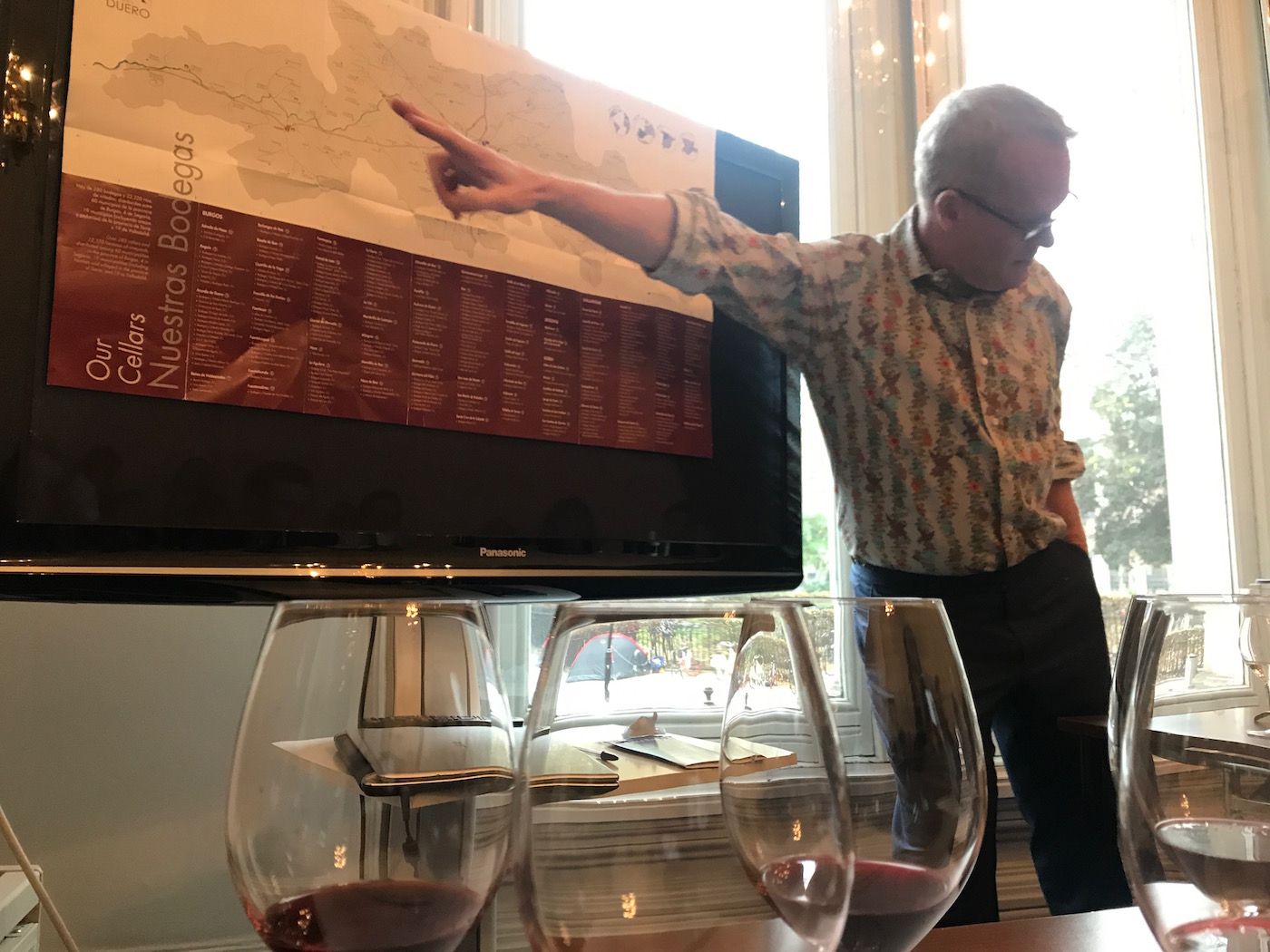Scroll down for full tasting notes of 10 of Tim Atkin’s Top 100 Ribera Del Duero wines
It’s odd, given how many of Spain’s top wines come from Ribera Del Duero, that it should be the subject of such criticism. 2018 was no different in that one leading critic laid into the region calling it ‘samey’; another critic I talked to at Tim Atkin’s Top 100 Ribera Del Duero tasting in December said that she couldn’t tell the wines apart.
“Look!” she cried, pointing at a row of identical birds on a wire outside the London venue, “that’s the same as this tasting… they’re all the same.”

The Ribera Del Duero London tasting, December 2018
I beg to differ and one aspect of Atkins’ masterclass, in which we looked at 10 of his favourites, was showing just how different they are. Sure, most of them are 100% Tempranillo, have robust acidity, a degree of concentration in their fruit and have a real freshness to the palate – but the variety in different styles is huge as a result of altitude, soil (of which there are 30 types) and winemaking style which, combined here, are far more important than East/West orientation.
Ribera Del Duero has a climate of extremes, one of the shortest growing periods in the world, with a massive diurnal range – in summer this can track up to 28 degrees between day and night.
“Summer here is a bit like that description of La Mancha: “Three months of winter and nine months of hell”,” grins Atkin.
Aside from the winemaking styles which vary considerably, Atkin points out the age of the vines here. A third of all the vines across the 22,552 hectares run by 311 wineries (over 102 communes in four provinces) are bush vines
“Many of them are far older than the 35 years required to call bush vines ‘old’ in South Africa. There are a lot of old bush vines here – 817 hectares of vines were planted before 1920.”
Grapes have been grown here far longer, of course, since Roman times, although the modern industry kicked off from 1838 when estates started importing Bordeaux varieties – 20% still have Bordeaux varieties. A lot of the vines were abandoned after the Civil War when it was more profitable to grow cereal crops, but in the past few decades the region has refound its dynamism with a lot of investment and new plantings.
And so to the 10 wines….
All of the wines are 100% Tempranillo apart from two that have 10% Cabernet Sauvignon and 5% Merlot and 8 that have 20% Cabernet Sauvignon and Merlot in the blend.

Finca Los Hoyales, Cruz de Alba, 2014
Always a joy to drink this minimal intervention wine from low-yielding, 53 year old vines on the estate’s best plot within Ribera’s ‘Golden Mile’, that is normally associated with the bigger names of the region – Vega Sicilia, Pingus and so on. The fermentation and malo are done in new French oak where it rests on the lees for 22 months with no racking and the wine is then bottled, unfiltered where it spends another 10 months. It is very classy, deep ruby, garriguey nose with red ripe fruits, blackberry jam, blueberry coulis and a bright backbone of acidity. Concentrated but elegant at the same time with a lovely long, juicy finish. (Enotria & Coe)
Viña Sastre Pesus, Hermanos Sastre, 2014
Off-the-scale impressive with a chunky €270 bottle price tag to match (one of most expensive in the region). It also has the curious honour of being vinified in 150% new wood, where after fermentation in 100% new barrels, 50% is re-fermented again in new oak. The juice comes from a blend of Tempranillo (80%) and Cab Sauv and Merlot, from 80-100 year old low density bush vines at 840m altitude. The wine is aged for 20 months. The nose is profound and amazingly powerful – in the mouth it is big, smooth, voluptuous with a stony texture and a nice citrus centre. A really big, fleshy, dense powerhouse of a wine. (City Wine Collection)
Mirum, Bodegas Valdaya, 2016
A future superstar of Ribera Del Duero- (uncertified) organic, high altitude, a mix of wood ages and formats, 35% vinified in concrete. It has all the characteristics you’d expect from 100% Tempranillo, except it’s fantastically refreshing (and that with 14.5% ABV!) (Bancroft)
Dominio de Atauta, 2015
100% Tempranillo from the best old vines (120-160 year old) in 25 different vineyards at 1000m altitude, aged for 16 months in a variety of French aged oak. After a nose which is all about the crushed rock you get a wonderful chalky texture which comes from the calcareous soils, the mouthfeel is full and quite rounded – a reflection of the hot 2015 vintage – but not as much as you might expect from a 15% ABV. Bit closed and tannic but delicious still. (Boutinot)
Finca Los Quemados, Goyo García Viadero, 2016
The only really ‘natural wine’ in the selection tastes very different indeed – black fruit, liquorice on the nose and a powerful but fresh blood orange the dominant flavour. 100% Tempranillo grown on red clay soils, unfixed and unfiltered. Unusual, very different, but an interesting change from the run-of-the-mill Riberas. (Raeburn)

Corimbo I, Bodegas La Horra, Reserva, 2013
A bad (and current) vintage but you wouldn’t have guessed – the aromas are delicious and draw you in, there are very dry tannins at the core and a pleasing dry stone texture. It’s fresh, with lively acidity, the wine feels lighter than the 14% ABV and there’s a sweet edge that comes from the 20% American oak (80% French) that the wine has been aged in for 16 months, following fermentation in large oak vats. (Mentzendorff)
Juegabolos, Valderiz, 2015
This is the top single vineyard wine from the region’s organic pioneer, the juice coming from 30 year old vines. Natural yeasts, malolactic fermentation in oak barrels and then 22 months of oak barrel ageing (80% French). The tannins for this were mouth-puckering, the oak not so well integrated in my mind with a creaminess coming from the 20% American oak. Maybe this is a reflection of difficulties with the hot vintage of 2015 or else the wine just needs a lot more time in bottle. (Great Wine Estates)
Valsotillo Finca Buenavista, Bodegas Ismael Arroyo, 2014
Vines are 850m high, goblet pruning, 50/50 French and American oak barrel-ageing. Great balance to the wine and good integration of the oak, nose was a bit dumb but delicious blue/ black fruit flavours. (Boutinot)
Viña Magna, Dominio Basconcillos, Reserva, 2014
People said that 980m was a “crazy” height for the vines that help make this wine, especially for getting the 10% Cab Sauv to ripen. These are 80 year-old vines on clay-calcareous and loamy-sandy soils. Aged for 24 months in new French oak. Creaminess and bit of sweetness from the oak, notes of fresh herbs and a twist of tobacco. Quite woody and massive length – really made for drinking in 10 years time. (seeking representation)
Yotuel Finca La Nava, Bodegas Y Viñedos Gallego Zapatero, 2014
A relative newcomer, this winery being set up in 1996, hand harvested 20 year old Tempranillo, natural yeasts, macerated for 16 days with malolactic in French oak where the juice remains for 14 months. The nose was quite dumb on the day but the wine shows massive potential – lovely texture, very fresh and balanced between the acidity and the lovely long flavours of black fruit. (seeking representation)










































